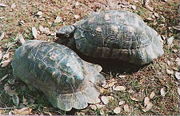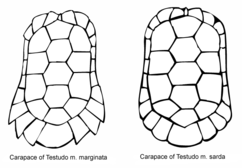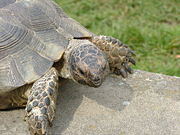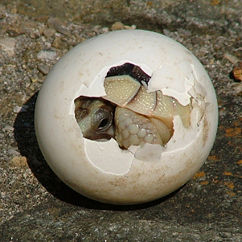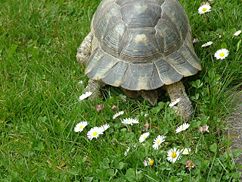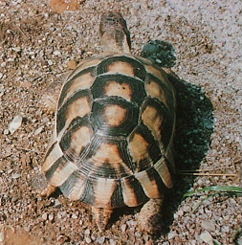Marginated Tortoise
2008/9 Schools Wikipedia Selection. Related subjects: Insects, Reptiles and Fish
| Marginated Tortoise | ||||||||||||||||
|---|---|---|---|---|---|---|---|---|---|---|---|---|---|---|---|---|
 Sardinian Marginated Tortoise
Testudo marginata sarda |
||||||||||||||||
| Conservation status | ||||||||||||||||
| Scientific classification | ||||||||||||||||
|
||||||||||||||||
| Binomial name | ||||||||||||||||
| Testudo marginata Schoepf, 1789 |
||||||||||||||||
| Subspecies | ||||||||||||||||
but see text |
||||||||||||||||
| Synonyms | ||||||||||||||||
|
Testudo weissingeri Bour, 1995 |
The Marginated Tortoise (Testudo marginata) is a species of tortoise found in Greece, Italy and the Balkans in southern Europe. It is the largest European tortoise, reaching a weight of up to 5 kg (11 pounds) and a length of 35 cm (14 inches). Its shell is oblong and has a notable thickness around the middle of the body. The posterior end of the shell has a saw-like formation, flanged outward like a bell. The carapace of adult specimens is almost completely black, with yellow highlights. The front sides of the limbs are covered with large scales. The tail is notable for a lengthwise marking and for an undivided carapace over the tail. The Marginated Tortoise is herbivorous, and hibernates for the winter.
Taxonomy
The Marginated Tortoise was formally described by German naturalist Johann David Schoepf in 1789, its specific epithet marginata a straightforward derivation from the Latin term for 'marginated'.
The nominate subspecies is the Greek Marginated Tortoise, Testudo marginata marginata. Three additional taxa of Marginated Tortoises have been named:
The Sardinian Marginated Tortoise (Testudo marginata sarda) is the name usually used to separate the population on Sardinia. These tortoises have less strongly bent tiles in the posterior of the carapace, and the posterior of the carapace is almost smooth compared with the saw-like Testudo marginata marginata. Clearly distinct according to morphology and entirely allopatric, it cannot be distinguished by mtDNA cytochrome b and nDNA ISSR sequence analysis. Lineage sorting has not occurred to a considerable degree; consequently, the more geographically isolated Sardinian population is presumably of quite recent origin.
Indeed it appears to derive from a deliberate introduction by humans. Though it is not clear whether this occurred in prehistoric times or more recently, this might be resolved by dating subfossil remains. Sequence evolution at least in mtDNA is known to proceed much more slowly in some turtles and tortoises than in others; the rate of the mitochondrial 12S rRNA gene in Testudo is probably a rather low 1-1.63% per million years (as this fits best the paleobiogeographical situation), limiting the resolution provided by molecular systematics.
An extinct subspecies described as T. marginata cretensis persisted on Crete before the end of the last ice age and perhaps into early historic times
A population of small and light-colored Marginated Tortoises exists on the southwestern coast of the Peloponnesus, between Kalamata and south of Stoupa. The so-called "Dwarf Marginated Tortoise" was described as a new species Testudo weissingeri, but it is not recognizably distinct phylogenetically. Unlike the Sardinian population, it occupies an extremely restricted range with very arid habitat, and its apomorphies seem related to this. Considering ice age-associated climate and sea level changes, this population is probably not older than a few thousand years; as it is not geographically isolated, it should be considered a local form, and not even a subspecies Testudo marginata weissingeri. It is notable that a similar situation is found in Hermann's Tortoises living in the same region.
Testudo marginata is also closely related to the Greek Tortoise or Spur-thighed Tortoise (Testudo graeca). Both have very similar bodily characteristics, an oblong carapace, large scales on the front legs, large covering for the head and cone-like scales on the upper thigh, undivided tail covering, moveable stomach plates, and lack of a tail spike. Presumably, Testudo marginata diverged from ancestral Testudo graeca as a population more suited for life in the mountainous regions. Evidence in favour of this is the wide geographical region and the extremely large number of subspecies of Testudo graeca, including a subspecies in Turkey with strongly bent carapace tiles, like the Marginated Tortoise. Testudo marginata on the other hand, despite the two subspecies, presents a much more unified appearance, which points toward an earlier appearance in evolutionary history. In captivity, the two species often cross-breed, but this should be avoided.
According to the 2005 DNA sequence data, these species do not seem to hybridize to a notable extent in the wild, though they are obviously very close relatives, and as evidenced bby morphology some allele flow still occurs, but slowly. The Egyptian Tortoise appears to represent a lineage that diverged from the same ancestral stock southwards into northeastern Africa around the same time as the Marginated Tortoise's ancestors diverged in Greece. These two are actually more similar to each other than to T. graeca regarding DNA sequence data, but considering biogeography, this is either due to (rather unlikely) dispersal across the Mediterranean, or the supposed " clade" is invalid and the similarity due to convergent evolution.
Description
The Marginated Tortoise is the largest European tortoise, reaching a weight of up to 5 kg (11 pounds) and a length of 35 cm (14 inches). Its shell is oblong and has a notable thickness around the middle of the body. The posterior end of the shell has a saw-like formation, flanged outward like a bell. The carapace of adult specimens is almost completely black, with yellow highlights. The ventral shell is lighter coloured and has pairs of triangular markings with the points facing the rear of the animal. The front sides of the limbs are covered with large scales. In old female specimens, the rear flaps of the underside of the plastron are somewhat moveable. The tail is notable for a lengthwise marking and for an undivided carapace over the tail. Males have a longer tail, which is thicker at the base than the females. Their underside is more strongly indented. Males are also often larger than the females. The females lay their hard-shelled spherical eggs in the soil in May and June.
Distribution and habitat
The natural range of the Marginated Tortoise is southern Greece, from the Peloponnesus to Mount Olympus. They are also found in isolated zones of the Balkans and Italy, and northeastern Sardinia.
The Marginated Tortoise lives in more mountainous regions than Herman's Tortoise (Testudo hermanni). It can be found in elevations as high as 1,600 m (5,250 feet). The black colour of the carapace is helpful for survival in this environment, as it allows the tortoise to absorb a great deal of heat in a short time, helping it maintain its body temperature. Early in the morning, Marginated Tortoises bask in the sun to raise their body temperature, and then search for food. After feeding, the tortoises return to their shelters in the hot midday hours, leaving them again in the late afternoon.
Behaviour
Diet
Marginated Tortoises are herbivorous, their diet consisting primarily of plants from their native Mediterranean region. In captivity, the primary foodstuffs are dandelions, clover, salad leaves such as rocket or watercress, and also leaves from plantain, radish, and crowfoot plants. Sometimes even grass and hay will be eaten. The feeding of fruit and tomatoes is to be discouraged as they may cause diarrhea. Lettuce will be eagerly devoured, but owing to its low nutrient value should not generally be given. Protein levels in the diet should be kept very low and in no account should they be given sources of animal protein such as meat, snails, worms, and cat, dog or terrapine food.
Additionally they should be given daily calcium supplements that are essential for a correct shell development. A mixture of various calcium salts is best, mainly calcium lactate, and calcium carbonate, with no phosphorus content.
Phosphorus inhibits absorption of calcium and so a high phosphorus content in the diet can cause abnormal development ("shell pyramiding") even though calcium supplements are given on a daily basis.
Reproduction
Immediately after waking from hibernation the mating instinct starts up. The males follow the females with great interest, encircling them, biting them on the limbs, ramming them, and trying to mount them. During copulation, the male opens his mouth, showing his red tongue and making loud cries. The tone of the copulation cry is almost sobbing with long, deep tones, in contrast to Testudo hermanni, in which there is a much higher-toned peeping noise.
During mating, the female stands still and holds her head to the side, looking up to see the opened mouth of the male. It appears that the red tongue serves a signalling function. The female moves her head from left to right in the same rhythm as the male's cries.
Afterwards the female seeks out an adequate location to lay her eggs. Once such a place is found, the female stands still, propping both front legs firmly against the ground. Then she digs out a hole with her hind legs, alternating between left and right, beginning with simply scratching the ground but eventually moving large quantities of soil which are piled up beside the hole. The depth of the hole is determined by the length of her hind legs. If the ground is too hard to dig, the female releases water from her anal gland to soften it.
Once the hole is dug egg laying begins. Each egg is gently rolled back into the hole. After the last egg the female immediately begins refilling the hole, again using her hind legs. Finally, she stamps the opening closed with her feet so that the ground regains its natural hardness. Larger animals may lay eggs as many as three times per summer, with about 15 eggs per clutch.
The incubation period averages about 100 days under natural conditions, which is relatively short among tortoises. Many tropical tortoises have incubation periods of up to 200 days. The relatively short time is an adaptation to the subtropical Mediterranean climate, where the summers are not as long. In an incubator, this time is notably shorter: with an incubation temperature of 31.5 °C (89 °F) the eggs will begin hatching after 60 days.
Unlike bird eggs, the yolk and albumen of reptile eggs are not separated by a membrane. After a few days, the heavy yolk components sink to the bottom of the egg. On top of this floats the embryonal disk, surrounded by albumen. For this reason the tortoise eggs cannot be turned after the yolk settles without damaging or killing the embryo.
It is possible to see with the naked eye if the eggs are developing healthily. Freshly laid eggs have a gray-white colour. Shortly thereafter, a bright white spot forms on the uppermost point of the egg. This spot gradually grows until the entire egg is bright white.
After the embryo has developed fully in the egg, the young animal breaks the shell with its egg tooth from inside, creates a small opening, and for the first time fill its lungs with air. Afterwards, it pulls back into the egg and works on the shell with its beak until it opens completely. In nature, the animal remains below ground for the first two weeks. Here it is safe from predators yet is still able to grow, as it is nourished by the yolk sac. The young animals lead cautious and secretive lives, normally remaining in the shade. They avoid full sunlight because of the great danger of overheating.
Marginated Tortoises grow very rapidly. In an ideal biotope, or with good handling, they gain 100–500 g (4–17 oz) yearly. This quick rate of growth lasts throughout their youth. After the twentieth year of life, further growth is minimal. They may live to between 100 and 140 years, according to the best estimates of scientists.
In captivity
In a terrarium
Tortoises can thrive in captivity if the owner understands their needs well. A heat lamp is attached to the tortoise's table, directed in such a way that the 60- watt reflector bulb is some 15–20 cm (6–8 in) from the floor of the table, which is covered with about 5 cm of substraite, loam based soil and play sand. When the lamp is turned on in the morning, the animals emerge from the ground, bask in the light to warm themselves, and begin to eat. They should be fed several times a day with clover, dandelions and garden weeds (check first as a few are harmful. Some owners give pellet food occasionally, these should be avoided, only feed your tortoise what they would naturally eat in the wild, their digestive systems do not cope well with protein, of which there is a lot in pellet foods. The animals also require ultraviolet light, thus they should be allowed to bask in the sunlight daily, but for only a short period of time. In the summer, they can be taken outdoors for this purpose, in the winter if not hybernated they need access to UVB light every day. Care must be taken to avoid allowing the tortoise to overheat (use a digital thermometer to keep a check).
Outdoors
In temperate zones, Marginated Tortoises can be kept outside from approximately mid-March to October. Their pen should be in the sunniest place in the garden, preferably close to the house. It is important to provide a wooden house where they can get into the shade. They should be provided enough gravel that they can completely bury themselves when needed.
The animals will leave the house in the morning, warm themselves, and eat. Afterwards, they return to the house. In the late afternoon, they will reemerge from their shelter. Tortoises do not need as much sunlight as many assume is required for a reptile. By October, they will take longer and longer pauses during the day. At this point, they should be transferred into a roomy crate filled with dry leaves and kept in a cool room. With a temperature under 10 °C (50 °F), they will hibernate until mid-March, though younger animals will awaken much earlier.
